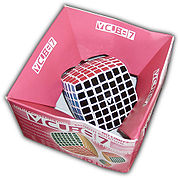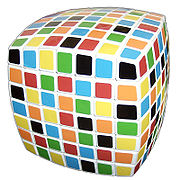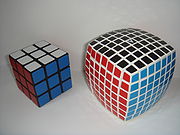
V-Cube 7
Encyclopedia

Rubik's Cube
Rubik's Cube is a 3-D mechanical puzzle invented in 1974 by Hungarian sculptor and professor of architecture Ernő Rubik.Originally called the "Magic Cube", the puzzle was licensed by Rubik to be sold by Ideal Toy Corp. in 1980 and won the German Game of the Year special award for Best Puzzle that...
. It was invented by Panagiotis Verdes and is produced by his company, Verdes Innovations SA. Like the 5×5×5
Professor's Cube
The Professor's Cube is a mechanical puzzle, a 5×5×5 version of the Rubik's Cube. It has qualities in common with both the original 3×3×3 Rubik's Cube and the 4×4×4 Rubik's Revenge, and knowing the solution to either can help when working on the 5×5×5 cube....
, the V-Cube 7 has both fixed and movable center facets.
Mechanics



V-Cube 6
The V-Cube 6 is the 6×6×6 version of Rubik's Cube. Unlike the original puzzle , it has no fixed facets: the center facets are free to move to different positions...
uses essentially the same mechanism, except that on the latter the central rows, which hold the rest of the pieces together, are completely hidden.
There are 150 center pieces which show one color each, 60 edge pieces which show two colors each, and eight corner pieces which show three colors. Each piece (or quintet of edge pieces) shows a unique color combination, but not all combinations are present (for example, there is no edge piece with both red and orange sides, since red and orange are on opposite sides of the solved Cube). The location of these cubes relative to one another can be altered by twisting the outer layers of the Cube 90°, 180° or 270°, but the location of the colored sides relative to one another in the completed state of the puzzle cannot be altered: it is fixed by the relative positions of the fixed center squares and the distribution of color combinations on edge and corner pieces.
Currently, the V-Cube 7 is produced with white plastic as a base, with red opposite orange, blue opposite green, and yellow opposite black. The fixed black center piece is branded with the letter V. Verdes also sells a version with black plastic and a white face, with the other colors remaining the same.
Unlike the flat-sided V-Cube 6, the V-Cube 7 is noticeably rounded. This departure from a true cube shape is necessary, since a 7×7×7 would be impossible to construct with uniform pieces. Note from the image at right that if a 7×7×7 were to be constructed with layers of identical thickness the (red colored) corner pieces would lose contact with the body of the cube when a side was rotated 45 degrees and fall out. The V-Cube 6 and V-Cube 7 both solve the problem by using thicker outer layers. The rounded shape of the V-Cube 7 helps disguise this.
Permutations


Any permutation of the corners is possible, including odd permutations. Seven of the corners can be independently rotated, and the orientation of the eighth depends on the other seven, giving 8!
Factorial
In mathematics, the factorial of a non-negative integer n, denoted by n!, is the product of all positive integers less than or equal to n...
×37 combinations.
There are 144 movable centers, consisting of six sets of 24 pieces each. Within each set there are four centers of each color. Centers from one set cannot be exchanged with those from another set. Each set can be arranged in 24! different ways. Assuming that the four centers of each color in each set are indistinguishable, the number of permutations of each set is reduced to 24!/(4!6) arrangements, all of which are possible. The reducing factor comes about because there are 4! ways to arrange the four pieces of a given color. This is raised to the sixth power because there are six colors. The total number of permutations of all movable centers is the permutations of a single set raised to the sixth power, 24!6/(4!36).
There are 60 edge pieces, consisting of 12 central, 24 intermediate, and 24 outer edges. The central edges can be flipped but the rest cannot (because the internal shape of the pieces is asymmetrical), nor can an edge from one set exchange places with one from another set. The five edges in each matching quintet are distinguishable, since corresponding non-central edges are mirror images of each other. There are 12!/2 ways to arrange the central edges, since an odd permutation of the corners implies an odd permutation of these pieces as well. There are 211 ways that they can be flipped, since the orientation of the twelfth edge depends on the preceding eleven. Any permutation of the intermediate and outer edges is possible, including odd permutations, giving 24! arrangements for each set or 24!2 total, regardless of the position or orientation any other pieces.
This gives a total number of permutations of

The entire number is 19 500 551 183 731 307 835 329 126 754 019 748 794 904 992 692 043 434 567 152 132 912 323 232 706 135 469 180 065 278 712 755 853 360 682 328 551 719 137 311 299 993 600 000 000 000 000 000 000 000 000 000 000 000 (roughly 19,501 sexvigintillion or 19.5 sexvigintilliard on the long scale
Names of large numbers
This article lists and discusses the usage and derivation of names of large numbers, together with their possible extensions.The following table lists those names of large numbers which are found in many English dictionaries and thus have a special claim to being "real words"...
or 19.5 duoquinquagintillion on the short scale).
However, the fixed black center piece is marked with a V, which can be oriented four different ways. This increases the number of patterns by a factor of four to 7.80×10160, although any orientation of this piece could be regarded as correct.
Solution

Another strategy is to solve the edges of the cube first. The corners can be placed just as they are in any previous order of cube puzzle, and the centers are manipulated with an algorithm similar to the one used in the 4×4×4 cube.
Records
The current world record for the V-Cube 7 is held by Michal Halczuk of Poland, set at a time of 3:13.19 at the Polish Nationals 2011. He also holds the best average record of 3:25.10, set at the Swierklany Open 2011.See also
- Pocket CubePocket CubeThe Pocket Cube is the 2×2×2 equivalent of a Rubik's Cube. The cube consists of 8 pieces, all corners.-Permutations:...
(2×2×2) - Rubik's CubeRubik's CubeRubik's Cube is a 3-D mechanical puzzle invented in 1974 by Hungarian sculptor and professor of architecture Ernő Rubik.Originally called the "Magic Cube", the puzzle was licensed by Rubik to be sold by Ideal Toy Corp. in 1980 and won the German Game of the Year special award for Best Puzzle that...
(3×3×3) - Rubik's RevengeRubik's RevengeThe Rubik's Revenge is the 4×4×4 version of Rubik's Cube. Invented by Péter Sebestény, the Rubik's Revenge was nearly called the Sebestény Cube until a somewhat last-minute decision changed the puzzle's name to attract fans of the original Rubik's Cube...
(4×4×4) - Professor's CubeProfessor's CubeThe Professor's Cube is a mechanical puzzle, a 5×5×5 version of the Rubik's Cube. It has qualities in common with both the original 3×3×3 Rubik's Cube and the 4×4×4 Rubik's Revenge, and knowing the solution to either can help when working on the 5×5×5 cube....
(5×5×5) - V-Cube 6V-Cube 6The V-Cube 6 is the 6×6×6 version of Rubik's Cube. Unlike the original puzzle , it has no fixed facets: the center facets are free to move to different positions...
- (6×6×6) - Combination puzzlesCombination puzzlesA combination puzzle, also known as a sequential move puzzle, is a puzzle which consists of a set of pieces which can be manipulated into different combinations by a group of operations. The puzzle is solved by achieving a particular combination starting from a random combination...

